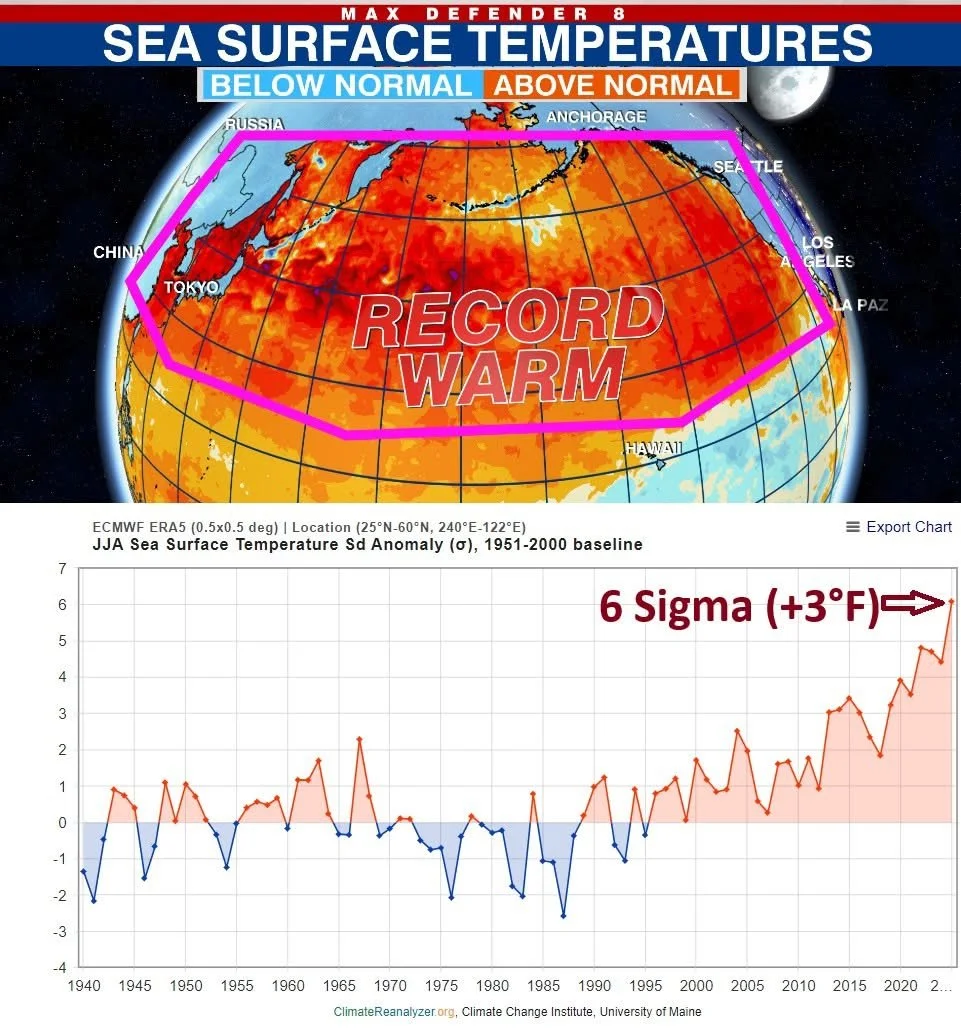Meta & Fysikken: Afsnit 114: Klima-status.
Vi tager lige en status på klimaet, her Oktober 2025.
1: Ocean Warming
2: Koralrev
3:Tipping Points
4: Permafrost i Rusland
5: Hvad gør vi med den CO2 vi indfanger?
6: Fuel Cells / Green Hydrogen plant
7: Kelp Farming in Norway
------------------------------------------------
1 : Ocean warming :
Jeff Berardelli (meterolog USA):
It's hard to overstate just how off the charts warm the Pacific is right now. The swath of the basin from California to Japan (a HUGE area) from 25N to 60N is ~3F (1.6C) above normal. To put it into math terms that is 6 Sigma/ standard deviations above the mean. I won't bother calculating the chances of this happening against the late 20th century climate - let alone the pre-industrial climate - because the numbers would show it simply could never happen without global warming.
So let's talk about why this is happening. Since the last El Nino a couple of years ago the ocean has been rearranging its warm/cool water, as it typically does as a normal part of it's natural oscillation. (This summer a record ridge/ heat dome was parked over the N Pacific).
But each next time this configuration lines up (warm north Pacific/ cool tropical Pacific) it piles on a higher and higher baseline temperature over time due to greenhouse warming, air pollution reduction, and the feedbacks (clouds & direct insolation) of both. So we end up with the bottom chart which shows the standardized anomaly (departure from normal) is sloping upward at a very unnatural and alarming rate.
2: Koralrev
https://videnskab.dk/naturvidenskab/oejenaabner-genopretning-af-koraller-kan-ikke-redde-verdens-rev/
3: Tipping Points
https://videnskab.dk/naturvidenskab/tipping-points-lyder-skraemmende-men-der-er-haab-endnu/
4: Permafrost i Rusland:
https://videnskab.dk/naturvidenskab/klimabombe-i-rusland-danske-forskere-advarer-om-alvorlig-mangel-paa-viden
Også:
Eksploderende Methan gas i Siberien:
https://www.sciencealert.com/mysterious-giant-exploding-craters-in-siberia-may-finally-be-explained
5:Hvad gør vi med den CO2 vi indfanger
https://videnskab.dk/teknologi/hvad-goer-vi-med-den-co2-vi-fanger/
Vi sender noget af den tilbage til oliefelterne vi har tømt i de danske farvande. Kilde: Royalt halløj
----------------------------
6: Tysklands største Hydrogen fabrik:
Germany's largest commercial renewable hydrogen factory is the 10 MW plant in Schwäbisch Gmünd, opened by Lhyfe in October 2025. The facility can produce up to 4 tons of renewable hydrogen per day and is Lhyfe's largest outside of France. While it's the largest operational commercial plant, there are larger-scale projects planned for the future in Germany, such as a 130 MW plant planned for Prenzlau by ENERTRAG.
https://engineerine.com/largest-green-hydrogen-plant/
A green hydrogen factory is good for the climate because it can be produced using renewable energy, with zero greenhouse gas emissions, and can replace fossil fuels in sectors that are hard to electrify, like heavy industry. When used in a fuel cell, hydrogen only releases water vapor and warm air, making it a clean energy carrier that can also store and deliver renewable energy.
#
Hydrogen Fuel Cell makes electricity directly. They also produce water vapor, heat and, depending on the fuel source, very small amounts of nitrogen dioxide and other emissions.
-------------------------
7: Kelp farming in Norway
--------------------------------
8: State of Climate Action 2025:
https://www.wri.org/research/state-climate-action-2025
" It finds that recent progress toward 1.5°C-aligned targets has largely failed to materialize at the required pace and scale and highlights where action must accelerate this decade to reduce greenhouse gas emissions, scale up carbon removal and increase climate finance."
" Although more than three-quarters of indicators are heading in the right direction, progress is alarmingly inadequate, exposing communities, economies and ecosystems to unacceptable risks. Global efforts across 29 indicators are “well off track,” such that at least a twofold—and for most, more than a fourfold—acceleration will be required this decade to keep the 1.5°C limit within reach. "
Getting on track for 2030 and staying on track for 2035 demands an enormous acceleration of efforts across every sector. The world must, for example:
Phase out coal more than ten times faster — equivalent to retiring nearly 360 average-sized coal-fired power plants each year and halting all projects in the pipeline.
Reduce deforestation nine times faster. Current levels are far too high — roughly equivalent to permanently losing nearly 22 football (soccer) fields of forest every minute in 2024.
Expand rapid transit networks five times faster — equivalent to building at least 1,400 km (870 miles) of light rail, metro and bus lanes annually.
Lower consumption of beef, lamb and goat meat in high-consuming regions five times faster — equivalent to reducing consumption by 2 or fewer servings per week in North and South America, Australia and New Zealand.
Scale technological carbon dioxide removal more than ten times faster — equivalent to building nine of the largest direct air capture facilities currently under construction each month.
Increase climate finance by nearly $1 trillion annually — equivalent to roughly two-thirds of public fossil fuel finance in 2023.
